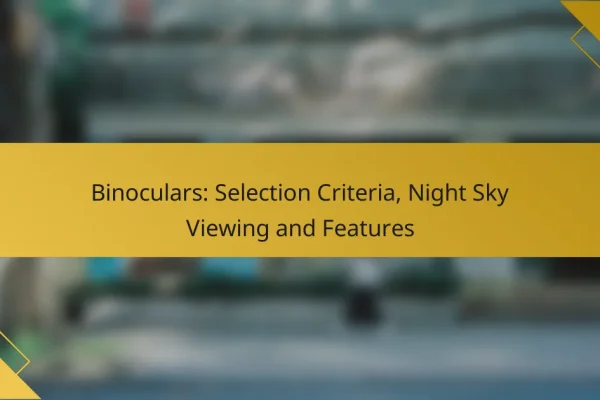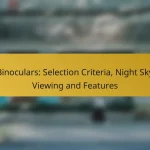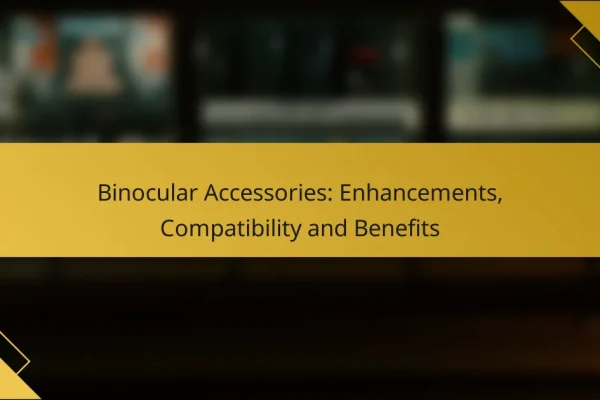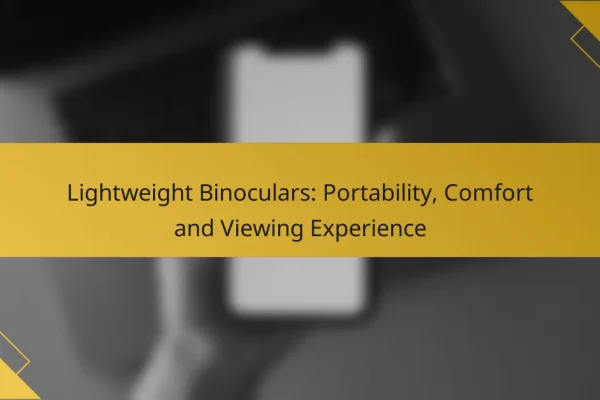What are the best binoculars for stargazing?
The best binoculars for stargazing typically feature a larger objective lens diameter and appropriate magnification to enhance visibility of celestial objects. Look for models that offer good light transmission and clarity, as these factors greatly influence your stargazing experience.
Orion 10×50 Astronomy Binoculars
The Orion 10×50 Astronomy Binoculars are a popular choice for stargazers due to their 10x magnification and 50mm objective lens, which provides a bright and clear view of the night sky. They are lightweight and easy to handle, making them suitable for extended viewing sessions.
These binoculars come with fully multi-coated optics, enhancing light transmission and reducing glare. They also feature a comfortable grip and adjustable eyecups, making them user-friendly for both eyeglass wearers and non-wearers.
Nikon Aculon A211 10-22×50 Binoculars
The Nikon Aculon A211 10-22×50 Binoculars offer versatile magnification options, ranging from 10x to 22x, allowing users to zoom in on distant celestial objects. The 50mm objective lens ensures ample light gathering, which is crucial for nighttime viewing.
These binoculars are designed with a durable rubber armor for a secure grip and shock resistance. Their multi-coated lenses improve brightness and clarity, making them a solid choice for both stargazing and terrestrial viewing.
Celestron SkyMaster 15×70 Binoculars
The Celestron SkyMaster 15×70 Binoculars are specifically designed for astronomical use, featuring a powerful 15x magnification and a large 70mm objective lens. This combination allows for exceptional light gathering, making faint stars and deep-sky objects more visible.
These binoculars are equipped with a sturdy construction and a tripod adapter, which is recommended for extended use to reduce hand shake. With their wide field of view and excellent optical performance, they are ideal for serious stargazers looking to explore the night sky in detail.
How to choose binoculars for stargazing?
Choosing binoculars for stargazing involves considering factors like magnification, lens size, and additional features that enhance your viewing experience. The right binoculars can significantly improve your ability to observe celestial objects clearly and comfortably.
Consider magnification and objective lens size
Magnification and objective lens size are crucial in determining how well you can see stars and other celestial bodies. A common choice for stargazing is binoculars with magnification between 7x and 10x and an objective lens size of 42mm to 50mm. This combination provides a good balance between brightness and detail.
Higher magnification can make images appear shaky and harder to stabilize, while larger objective lenses allow more light, improving visibility in dark conditions. Aim for binoculars that offer a good compromise between these factors to enhance your stargazing experience.
Evaluate field of view and exit pupil
The field of view refers to how wide an area you can see through the binoculars, while the exit pupil is the diameter of the beam of light exiting the eyepiece. A wider field of view, typically measured in degrees, allows you to track moving objects more easily, which is beneficial for observing stars and planets.
For stargazing, look for binoculars with an exit pupil of around 5mm to 7mm, as this range optimizes light transmission for night viewing. A larger exit pupil means brighter images, especially in low-light conditions, making it easier to spot faint stars.
Check for image stabilization features
Image stabilization features can significantly enhance your stargazing experience by reducing the effects of hand tremors and vibrations. Some binoculars come equipped with built-in stabilization systems that help maintain a steady image, allowing for clearer observations of celestial objects.
While image stabilization can add to the cost, it is particularly useful for high-magnification binoculars where even slight movements can lead to blurry images. If you plan to use your binoculars for extended periods, consider investing in models that offer this feature for a more enjoyable viewing experience.
What are the key features of stargazing binoculars?
Stargazing binoculars are designed with specific features that enhance the viewing experience of celestial objects. Key elements include multi-coated optics for improved light transmission, waterproof and fog-proof construction for durability, and a lightweight ergonomic design for comfortable use during extended periods.
Multi-coated optics for better light transmission
Multi-coated optics significantly enhance light transmission, allowing for brighter and clearer images of stars and planets. This feature is crucial for stargazing, especially in low-light conditions where every bit of light counts.
When selecting binoculars, look for those with fully multi-coated lenses, as they typically provide superior performance compared to those with only single or partially coated optics. A good rule of thumb is to choose binoculars with an objective lens diameter of at least 42mm for optimal light gathering.
Waterproof and fog-proof construction
Waterproof and fog-proof construction ensures that binoculars can withstand various weather conditions, making them suitable for outdoor stargazing. This feature is particularly important for users in humid or unpredictable climates, as it prevents internal fogging and damage from moisture.
Look for binoculars that meet the IPX7 or higher waterproof rating, which indicates they can be submerged in water without damage. Additionally, nitrogen or argon purging is a beneficial feature that helps prevent fogging inside the lenses.
Lightweight and ergonomic design
A lightweight and ergonomic design is essential for comfortable stargazing, especially during long sessions. Binoculars that are easy to hold and maneuver reduce fatigue and enhance the overall experience.
Consider models that weigh around 1-2 kg and have rubberized grips for better handling. Adjustable eyecups are also beneficial for users who wear glasses, allowing for a more comfortable viewing position.
Where to buy binoculars for stargazing?
You can find binoculars for stargazing at various retailers, both online and in physical stores. Consider factors like selection, price, and customer service when choosing where to buy.
Amazon for a wide selection
Amazon offers a vast array of binoculars suitable for stargazing, ranging from budget-friendly options to high-end models. You can easily compare prices, read customer reviews, and check ratings to find the best fit for your needs.
Look for brands like Celestron and Nikon, which are known for their quality optics. Pay attention to features such as magnification, lens diameter, and weight to ensure you select binoculars that enhance your stargazing experience.
Best Buy for in-store experience
Best Buy provides an excellent in-store experience for those who prefer to see and handle binoculars before purchasing. Knowledgeable staff can help you understand the differences between models and guide you to the best options for stargazing.
Additionally, Best Buy often has seasonal sales, making it a good place to find deals on popular brands. Check their website for availability and specific models in your local store.
OpticsPlanet for specialized options
OpticsPlanet specializes in optical equipment, making it a great choice for serious stargazers looking for high-performance binoculars. They offer a wide range of specialized models, including those with advanced features like image stabilization and night vision.
When shopping here, take advantage of their expert reviews and detailed product descriptions. This can help you make informed decisions based on your specific stargazing needs, whether you’re a beginner or an experienced astronomer.
What are the benefits of using binoculars for stargazing?
Using binoculars for stargazing offers several advantages, including improved visibility of celestial objects, greater portability than telescopes, and affordability for those new to astronomy. These benefits make binoculars an excellent choice for both casual observers and budding astronomers.
Enhanced visibility of celestial objects
Binoculars provide a wider field of view compared to the naked eye, allowing users to spot more stars, planets, and other celestial phenomena. With magnification typically ranging from 7x to 15x, they enhance the details of objects like the Moon’s craters or the rings of Saturn.
Additionally, binoculars often feature larger objective lenses, which gather more light. This capability makes it easier to observe faint objects, such as distant galaxies or nebulae, especially in darker environments away from city lights.
Portability compared to telescopes
Binoculars are lightweight and compact, making them easy to carry and set up for stargazing sessions. Unlike telescopes, which can be bulky and require more time to assemble, binoculars can be quickly grabbed and used at a moment’s notice.
This portability allows stargazers to explore various locations, whether in their backyard or at a remote site. They can easily fit into a backpack, making them ideal for hiking or camping trips where space is limited.
Affordability for amateur astronomers
Binoculars are generally more affordable than telescopes, with many quality options available for under $200. This lower price point makes them accessible for beginners who want to explore astronomy without a significant financial commitment.
Moreover, the maintenance costs for binoculars are minimal compared to telescopes, which may require additional accessories or regular upkeep. This affordability allows amateur astronomers to invest in other equipment or resources to enhance their stargazing experience.












